The first step is to head over to the Lucidor website. Here you can read up on Lucidor to get a better idea of if it’s right for you. When you’re ready, click the Download link at the top of the page.

Once the download page loads, click to download the installer of your choice. For this article we’ll be using the Linux version, but you can also grab the Windows or Mac installer (or the source code).

Note: For Linux users, the .deb file is for Debian/Ubuntu, while the .rpm is for Fedora/OpenSUSE/Mandriva users.
Once downloaded, run the installer to install Lucidor. You can use a GUI program or install it from the Terminal.

When the installation is done, you can delete the installer file, and should find Lucidor in your Applications menu, under Office.
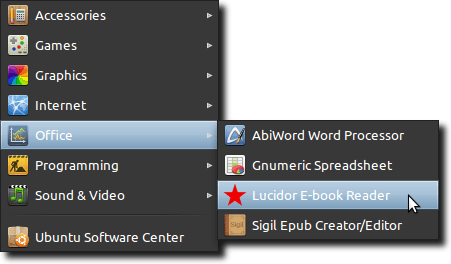
Go ahead and open it; it’s time to use it to read some books!
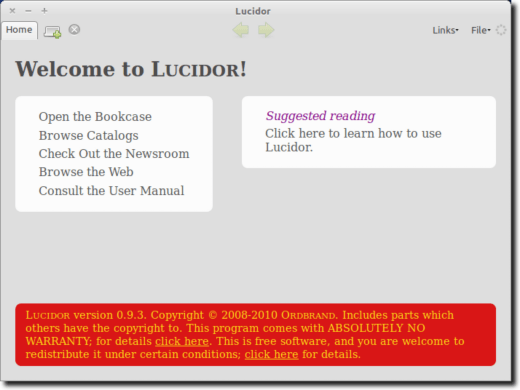
The main window is simple, yet still manages to include easy access to your Bookcase, allows you to browse catalogs, read from the Newsroom or the User Manual, and even browse the Web.
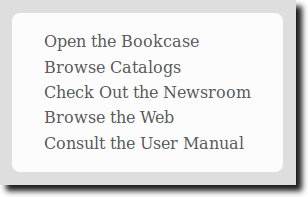
Note: It would also, if we’d used it previously, include a link to our most recently read ePUB.
To start using Lucidor, click the Open the Bookcase link. You’ll see a familiar 3-pane interface, with your Bookcase in the left column, the list of available books above on the right, and below, information about the highlighted book.
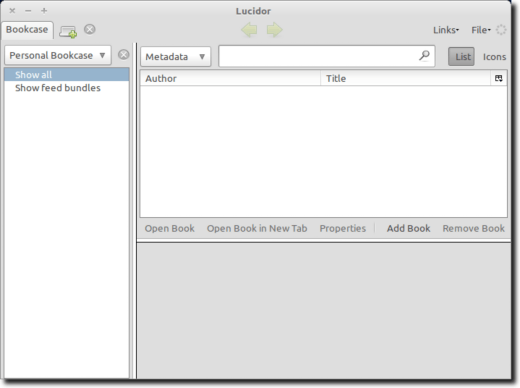
To add a book to your Bookcase, click the Add Book link.

A standard file picker will appear. Choose the ePUB you want to add to Lucidor. You can find good quality, free and legal ePUB files from Project Gutenberg and ManyBooks, as well as other places on the Web. Here we’ve added a copy of The Adventures of Sherlock Holmes, from Project Gutenberg.
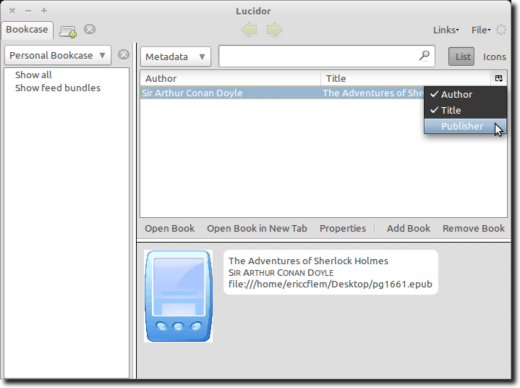
By default, Lucidor only uses the author or book title to organize your collection, but you could also use the publisher.
To get more information on a particular book, highlight it, then click the Properties link. A new window will appear, showing you all the pertinent metadata embedded in your ePUB file.

When you’re ready to read a book, highlight it, then click the Open Book or Open Book in New Tab link.

You can navigate through your ePUB by hitting the space bar (to move down one page), or by using the up and down arrows (to scroll up and down through the book). When you come to the end of a chapter, click the Previous or Next buttons in the lower right corner.

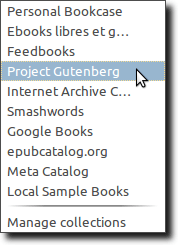
In addition to Project Gutenberg, Google Books, and Smashwords, you can use Feedbooks, which has access to hundreds of free, public domain ePUB files, all ready to be downloaded, right from inside Lucidor.
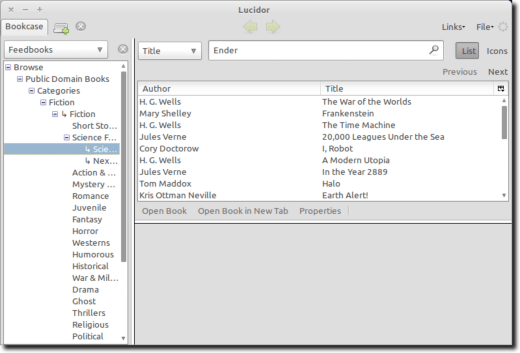
Finally, you can create your own ePUB files from Web feeds, using the Newsroom feed from the main Lucidor page. This is an experimental feature, but by entering in the URL for a feed (such as for a blog), you can create a news feed inside Lucidor itself. The service scans your feed URL, grabbing text, pictures and links to videos. You’ll need Internet access once you’ve saved the book to view videos, but the full text will always be available.
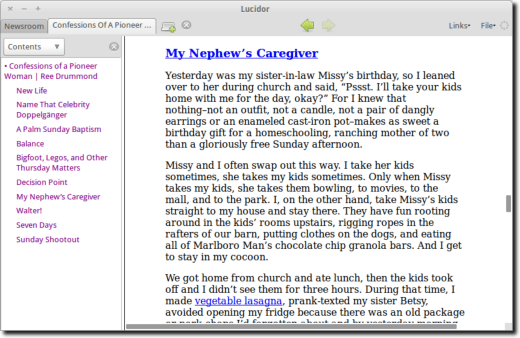
You will also find that Lucidor – even when reading from a saved version of your feed, recognizes that it originated from a feed and asks if you want to update it, which would pull in new posts.
Also, a single feed actually has the capabilities of being a bundle. Simply add multiple feeds, and they will be aggregated together. In this way, you can read up on a single topic, all from the same feed. As mentioned, this is experimental, but seemed to work pretty well.
There’s more to Lucidor than would appear at first glance. It is a great reader, but is more than just that. No, it can’t interface with your eBook reader like Calibre can, so if you need that feature, use Calibre. For basic reading, Lucidor is great. Lucidor is available for Linux, as well as Mac OS X and Windows.

Once the download page loads, click to download the installer of your choice. For this article we’ll be using the Linux version, but you can also grab the Windows or Mac installer (or the source code).

Note: For Linux users, the .deb file is for Debian/Ubuntu, while the .rpm is for Fedora/OpenSUSE/Mandriva users.
Once downloaded, run the installer to install Lucidor. You can use a GUI program or install it from the Terminal.

When the installation is done, you can delete the installer file, and should find Lucidor in your Applications menu, under Office.

Go ahead and open it; it’s time to use it to read some books!
Reading ePUB Files With Lucidor
When Lucidor Opens, you’ll see its main window.
The main window is simple, yet still manages to include easy access to your Bookcase, allows you to browse catalogs, read from the Newsroom or the User Manual, and even browse the Web.

Note: It would also, if we’d used it previously, include a link to our most recently read ePUB.
To start using Lucidor, click the Open the Bookcase link. You’ll see a familiar 3-pane interface, with your Bookcase in the left column, the list of available books above on the right, and below, information about the highlighted book.

To add a book to your Bookcase, click the Add Book link.
A standard file picker will appear. Choose the ePUB you want to add to Lucidor. You can find good quality, free and legal ePUB files from Project Gutenberg and ManyBooks, as well as other places on the Web. Here we’ve added a copy of The Adventures of Sherlock Holmes, from Project Gutenberg.

By default, Lucidor only uses the author or book title to organize your collection, but you could also use the publisher.
To get more information on a particular book, highlight it, then click the Properties link. A new window will appear, showing you all the pertinent metadata embedded in your ePUB file.

When you’re ready to read a book, highlight it, then click the Open Book or Open Book in New Tab link.

You can navigate through your ePUB by hitting the space bar (to move down one page), or by using the up and down arrows (to scroll up and down through the book). When you come to the end of a chapter, click the Previous or Next buttons in the lower right corner.
Do More Than Read Books With Lucidor
In addition to reading ePUB files, Lucidor does allow you to download them from a few places on the Web. To access these features, choose the Bookcase tab, but then click where it says Personal Bookcase to reveal a menu with other options.
In addition to Project Gutenberg, Google Books, and Smashwords, you can use Feedbooks, which has access to hundreds of free, public domain ePUB files, all ready to be downloaded, right from inside Lucidor.

Finally, you can create your own ePUB files from Web feeds, using the Newsroom feed from the main Lucidor page. This is an experimental feature, but by entering in the URL for a feed (such as for a blog), you can create a news feed inside Lucidor itself. The service scans your feed URL, grabbing text, pictures and links to videos. You’ll need Internet access once you’ve saved the book to view videos, but the full text will always be available.

You will also find that Lucidor – even when reading from a saved version of your feed, recognizes that it originated from a feed and asks if you want to update it, which would pull in new posts.
Also, a single feed actually has the capabilities of being a bundle. Simply add multiple feeds, and they will be aggregated together. In this way, you can read up on a single topic, all from the same feed. As mentioned, this is experimental, but seemed to work pretty well.
There’s more to Lucidor than would appear at first glance. It is a great reader, but is more than just that. No, it can’t interface with your eBook reader like Calibre can, so if you need that feature, use Calibre. For basic reading, Lucidor is great. Lucidor is available for Linux, as well as Mac OS X and Windows.


No comments:
Post a Comment